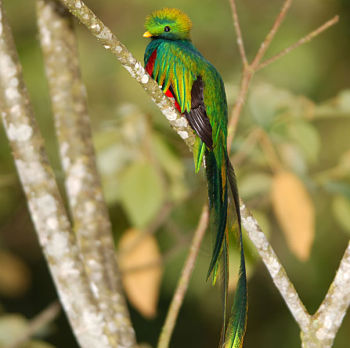

Colorful birds adorn a traditional huipil. Credit: RNuwer
Guatemala’s highlands are an explosion of color. Volcanoes shrouded in jungley green loom over craterous jade lakes. Nature’s palette doesn’t stop in the forest, either. Indigenous Mayans celebrate the landscape by incorporating festive environmental images onto their hand-woven blouses. Each town has its own distinct style, and colors range from neon pink to sunshine yellow. For birders in particular, the Maya fashion is a must-see: ladies often boast shirts covered in dozens of intricate, hand-woven birds.
 While many indigenous cultures around the world are shedding their native dress in favor of blue jeans and t-shirts, Guatemalan Maya still proudly sport their traditional clothing. “Their weaving tradition dates back over two millennia,” says Margot Blum Schevill, an independent anthropologist specializing in textiles and folk art. Maya women today still weave their own clothing using unique backstrap looms, and ancient sculptures show that early versions of these traditional devices date back to 700 A.D.
While many indigenous cultures around the world are shedding their native dress in favor of blue jeans and t-shirts, Guatemalan Maya still proudly sport their traditional clothing. “Their weaving tradition dates back over two millennia,” says Margot Blum Schevill, an independent anthropologist specializing in textiles and folk art. Maya women today still weave their own clothing using unique backstrap looms, and ancient sculptures show that early versions of these traditional devices date back to 700 A.D.
Mayan woman in an embroidered strawberry blouse.
Credit: RNuwer
A frenzy of birds, both fanciful and realistic, often adorns the blouses and huipiles—a specially formatted square-shaped overlay—of Maya women. The cloth on these garments is usually woven with a variety of bird, animal, or flower designs. Each woman’s huipil is personalized, expressing not only her community’s culture but also her individuality and style. “These weavers are artists,” Schevill says, “They love to do a little something special and you’ll never find two huipiles exactly the same.”

Maya fashions collide at the marketplace melting pot of Chichicastenango. Credit: RNuwer
Years ago, the embroidery was much more strictly defined according to community identity. By looking at a woman’s dress, Schevill says, you could tell exactly where she was from. But over time, things have changed, and women today wear the styles of other towns. For example, a double-headed eagle used to be associated with the town of Chichicastenango, a mountain hub known for its bustling weekly market. Called a kot in the Mayan language of Quiche, the two-headed raptor symbolized the act of looking both forward and backwards at the same time. Now the double-headed eagle can be seen in the textiles of other Guatemalan towns, too.

Can you spot five different bird-themed patterns on these rad textiles? Credit: RNuwer
While some birds like the double-headed eagle are mythical, Schevill says, others are based on common species that women may see in their courtyard while they weave. The Guatemalan national bird, the quetzal, often adorns all sorts of textiles. Its long, iridescent green tail feathers make it immediately recognizable. “It’s one of the most beautiful birds,” Schevill says, “and during ancient Mayan times its feathers were highly valued and traded.” It’s said that Montezuma had a cloak made entirely of quetzal feathers. Today, birders unfortunately have a better chance of spotting a quetzal on a Maya blouse than in the wild. The endangered species is confined to the highland habitats of northeastern Guatemala and other Central American countries.

A rare quetzal. Credit: Flickr, Josegoingindie
Luckily for birders and nature-lovers visiting the country, Maya markets often have avian-themed huipiles and blouses readily available. Tourists can pick up their own bird-covered clothing items, showing their enthusiasm for feathered friends and supporting local Mayan women in the process. “Nature is their source,” Schevill says of the indigenous artists, “They live with the flowers, they live with the birds. And their imagery comes from what is around them.”

What species might this be? Credit: RNuwer
See also: A tale of two habitats, Seeing scarlet, Stars, stripes . . . and feathers
